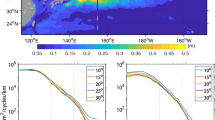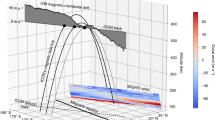Abstract
OVER a period of twelve months, measurements have been made at Seagrove Radio Research Station of the bearing and elevation angles of radio signals received from two transmitting stations at about the same distance but in directions differing by almost 90° from the receiving station. From these measurements the effective slopes of the ionosphere have been found to be related at places about 1,500 km. apart, and the average diurnal variation of these slopes has been measured.
This is a preview of subscription content, access via your institution
Access options
Subscribe to this journal
Receive 51 print issues and online access
$199.00 per year
only $3.90 per issue
Buy this article
- Purchase on Springer Link
- Instant access to full article PDF
Prices may be subject to local taxes which are calculated during checkout
Similar content being viewed by others
References
Whale, H. A., Proc. Phys. Soc., [B., 67, 553 (1954)].
Author information
Authors and Affiliations
Rights and permissions
About this article
Cite this article
WHALE, H. Widespread Diurnal Variations of Effective Slope of the Ionosphere. Nature 175, 77–78 (1955). https://doi.org/10.1038/175077b0
Issue Date:
DOI: https://doi.org/10.1038/175077b0
Comments
By submitting a comment you agree to abide by our Terms and Community Guidelines. If you find something abusive or that does not comply with our terms or guidelines please flag it as inappropriate.



